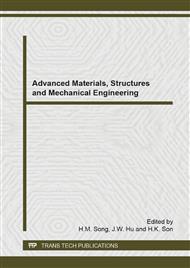p.466
p.470
p.476
p.482
p.487
p.494
p.499
p.504
p.509
Removal of Humic Material from Mineralized Algerian Water Using Alum and Local Clay as Coagulant Aid
Abstract:
The aim of this work was to evaluate the effects of different coagulation-flocculation conditions on the levels of natural organic matter removal for several mineralized water types in Algeria. First, trials are carried out on solutions prepared by dissolving humic acid in media with various degree of mineralization (distilled water and mineralized Algerian groundwater), using aluminium sulphate as coagulant. The effectiveness of the coagulation process appeared to depend not only on the pH of coagulation and coagulant dosages, but also inorganic constituents in water. Results showed obviously a stoechiometric relationship between the initial concentration of humic substances and optimal coagulant dosages for each water sample. Improvement of process performance is also investigated by using local clay as coagulant aid in coagulation-flocculation step. The use of bentonitic clay as a coagulant aid for alum improved the humic acid removal efficiency to some extent, especially when clay is added durind slow mix step. The experimental results of this study demonstrate the feasibility of removing humic substances from two surface waters using a flocculation-adsorption process.
Info:
Periodical:
Pages:
487-493
Citation:
Online since:
September 2014
Authors:
Keywords:
Price:
Сopyright:
© 2014 Trans Tech Publications Ltd. All Rights Reserved
Share:
Citation:


